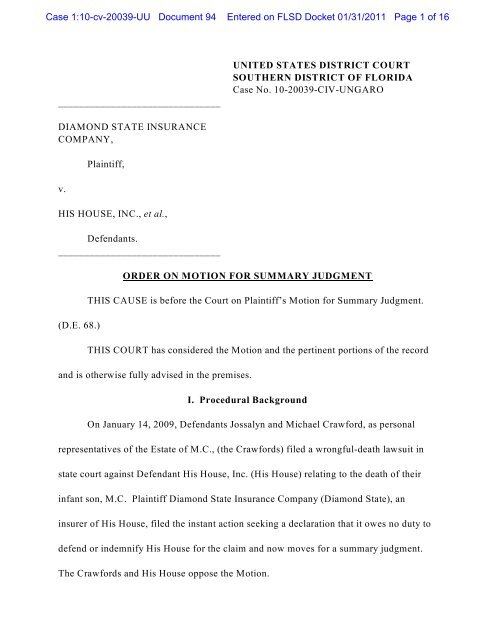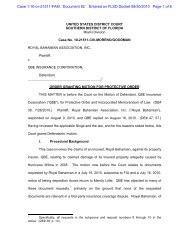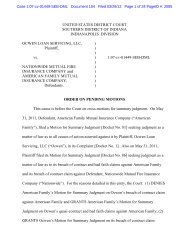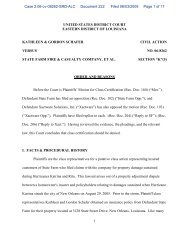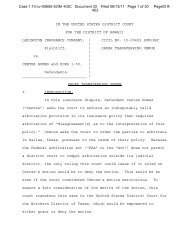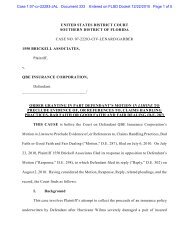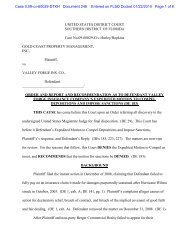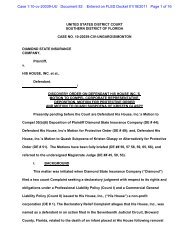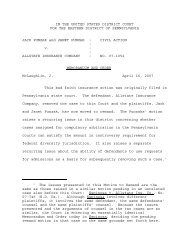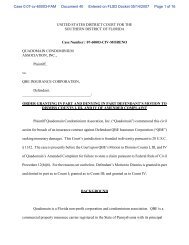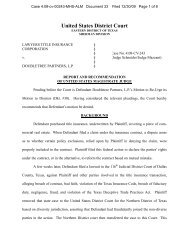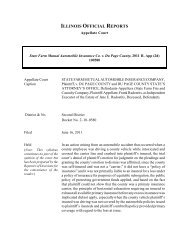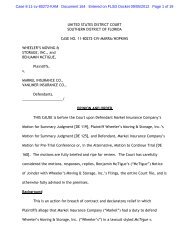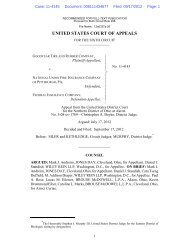Download Diamond State Insurance Co. v. His House Inc.
Download Diamond State Insurance Co. v. His House Inc.
Download Diamond State Insurance Co. v. His House Inc.
Create successful ePaper yourself
Turn your PDF publications into a flip-book with our unique Google optimized e-Paper software.
Case 1:10-cv-20039-UU Document 94 Entered on FLSD Docket 01/31/2011 Page 1 of 16_______________________________UNITED STATES DISTRICT COURTSOUTHERN DISTRICT OF FLORIDACase No. 10-20039-CIV-UNGARODIAMOND STATE INSURANCECOMPANY,v.Plaintiff,HIS HOUSE, INC., et al.,Defendants._______________________________(D.E. 68.)ORDER ON MOTION FOR SUMMARY JUDGMENTTHIS CAUSE is before the <strong>Co</strong>urt on Plaintiff’s Motion for Summary Judgment.THIS COURT has considered the Motion and the pertinent portions of the recordand is otherwise fully advised in the premises.I. Procedural BackgroundOn January 14, 2009, Defendants Jossalyn and Michael Crawford, as personalrepresentatives of the Estate of M.C., (the Crawfords) filed a wrongful-death lawsuit instate court against Defendant <strong>His</strong> <strong>House</strong>, <strong>Inc</strong>. (<strong>His</strong> <strong>House</strong>) relating to the death of theirinfant son, M.C. Plaintiff <strong>Diamond</strong> <strong>State</strong> <strong>Insurance</strong> <strong>Co</strong>mpany (<strong>Diamond</strong> <strong>State</strong>), aninsurer of <strong>His</strong> <strong>House</strong>, filed the instant action seeking a declaration that it owes no duty todefend or indemnify <strong>His</strong> <strong>House</strong> for the claim and now moves for a summary judgment.The Crawfords and <strong>His</strong> <strong>House</strong> oppose the Motion.
Case 1:10-cv-20039-UU Document 94 Entered on FLSD Docket 01/31/2011 Page 2 of 16II. Factual BackgroundThe following facts are undisputed. On February 6, 2007, the Broward1Department of Children and Families removed M.C. from Jossalyn Crawford’s home.(D.E. 1 p. 71.) M.C. was ultimately placed in the care and custody of <strong>His</strong> <strong>House</strong> and itsagent, foster-care-mother Kristen Glaspy. (D.E. 1 pp. 71–72.) Glaspy fed M.C. around12:00 a.m. on February 15, 2007 and last saw her alive around 12:30 a.m. (D.E. 1 p. 72.)Around 5:00 a.m., Glaspy found M.C. deceased in bed. (D.E. 1 p. 72.)<strong>His</strong> <strong>House</strong> immediately notified the police. (D.E. 70-1 p. 22; 70-3 p. 62.) And theMiami-Dade Medical Examiner Department began an investigation into the cause ofM.C.’s death. (D.E. 70-2 p.2) In July 2007, <strong>His</strong> <strong>House</strong> received a copy of the MedicalExaminer’s Report. (D.E 70-1 p. 14.) The report concluded the cause of death was anaccidental suffocation by blanket. (D.E. 70-2 p. 2.)After receiving the report in July 2007, <strong>His</strong> <strong>House</strong> anticipated a claim and reported2the incident to its insurers through its insurance broker. (D.E. 70-1 pp. 25, 40–43.) InOctober 2007, <strong>His</strong> <strong>House</strong> learned that ChildNet, <strong>Inc</strong>. (another entity involved in M.C.’s1The facts regarding M.C’s death are taken from the allegations of the Crawfords’ amendedcomplaint in the underlying state court action. The allegations are in accord with the undisputedfactual record. (D.E. 70-4 pp. 35–41.)2Almost a year after <strong>His</strong> <strong>House</strong> initially notified its insurers, counsel for <strong>His</strong> <strong>House</strong> sent a letterto an additional insurer, New Hampshire <strong>Insurance</strong> <strong>Co</strong>mpany, which referenced the notice sent inJuly 2007 and stated: “A claim was anticipated.” (D.E. 70-1 pp. 42–44; 70-2 p. 27.) And whenasked, in her deposition and in reference to this letter, whether <strong>His</strong> <strong>House</strong> “anticipated a claim”when it notified its insurers in July 2007, <strong>His</strong> <strong>House</strong>’s corporate representative answered “yes.”(D.E. 70-1 p. 44.)2
Case 1:10-cv-20039-UU Document 94 Entered on FLSD Docket 01/31/2011 Page 3 of 16care) had received a notice of intent to sue from the representatives of M.C.’s estate.(D.E. 70-1 pp. 30–32.) <strong>His</strong> <strong>House</strong> received a copy of a letter sent from the attorneyrepresenting M.C’s estate to ChildNet, <strong>Inc</strong>. and the Department of Children and Families 3which stated: “This correspondence is to advise you that litigation in this matter isimminent and that you have a duty to preserve all evidence that is in your possession ....”(D.E. 70-1 pp. 50–51; 70-2 pp. 41–44.)Around a year after first notifying its insurers, <strong>His</strong> <strong>House</strong> decided to switchinsurance brokers and insurers and executed an application for liability coverage from<strong>Diamond</strong> <strong>State</strong> on June 30, 2008. (D.E. 70-1 pp. 43–44 & 68; 70-17.) During theapplication process, <strong>His</strong> <strong>House</strong> informed <strong>Diamond</strong> <strong>State</strong> of the incident involving M.C.’sdeath. (D.E. 70-1 pp. 68–70.) No evidence suggests, however, that <strong>Diamond</strong> <strong>State</strong>represented its policy would cover claims arising from the incident.<strong>Diamond</strong> <strong>State</strong> approved the application and issued policy number SSB0583939 to<strong>His</strong> <strong>House</strong>. (D.E. 68-1.) The policy included both professional liability and commercialgeneral liability coverage provisions, which state the following in pertinent part:PROFESSIONAL LIABILITY DECLARATIONS* * *Item 3. Policy Period: From: June 30, 2008 To: June 30, 20093The letter states “M.C. was in the custody and care of DCF and/or ChildNet at the time of herdeath.” (D.E. 70-2 p. 42.) M.C.’s estate was apparently not yet aware of <strong>His</strong> <strong>House</strong>’sinvolvement3
Case 1:10-cv-20039-UU Document 94 Entered on FLSD Docket 01/31/2011 Page 4 of 16* * *Item 7. Retroactive Date: October 22, 2003* * *SECTION 1 - PROFESSIONAL LIABILITY COVERAGE1. Insuring AgreementWe will pay those sums that the insured becomes legally obligated topay as “compensatory damages” as a result of a “wrongful act.” Thisinsurance applies to injury only if a “claim” for damages to which noother insurance applies, because of the injury is first made against theinsurer and reported to us during the “policy period.” This insurancedoes not apply to injury caused by a wrongful act that ... wascommitted before the Retroactive Date shown in the Declarations orafter the “policy period.”2. Exclusions* * *This insurance does not apply to:* * *s. Any “claim”, “suit” or “wrongful act” that might result in a“claim” or “suit”, of which any insured had knowledge or couldhave reasonably foreseen, at the signing date of the application forthis insurance.SECTION VI - DEFINITIONS* * ** * *4. “Claim” means a written demand upon the insured for “compensatorydamages”, including, but not limited to, the service of “suit” orinstitution of arbitration proceedings against the insured. “Claim”includes reports of accidents, acts, errors, occurrences, offenses oromissions which may give rise to a “claim” under this policy. ...4
Case 1:10-cv-20039-UU Document 94 Entered on FLSD Docket 01/31/2011 Page 5 of 16(D.E. 68-1.)* * *11. “Suit” means a civil proceeding in which damages for injury to whichthis insurance applies are alleged. “Suit” includes an arbitrationproceeding alleging such damages to which you must submit orsubmit with our consent.12. “Wrongful act” means any act, error or omission in the furnishing ofprofessional social services. It includes the furnishing of food,beverages, medications or appliances in connection with thoseservices. All “wrongful acts” committed in the furnishing ofprofessional social services to any one person will be considered own“wrongful act.” ...* * *COMMERCIAL GENERAL LIABILITY COVERAGESECTION 1 - COVERAGES* * *COVERAGE A BODILY INJURY AND PROPERTY DAMAGELIABILITY1. Insuring Agreementa. We will pay those sums that the insured becomes legallyobligated to pay as damages because of “bodily injury” ... towhich this insurance applies.* * *b. This insurance applied to “bodily injury” ... only if:* * *(1) The “bodily injury” occurs during the policy period ....On January 14, 2009, the Crawfords filed the underlying lawsuit. The parties5
Case 1:10-cv-20039-UU Document 94 Entered on FLSD Docket 01/31/2011 Page 6 of 16dispute whether the claims against <strong>His</strong> <strong>House</strong> are covered under the policy.III. Summary Judgment StandardSummary judgment is authorized under Federal Rule of Civil Procedure (“Rule”)56 only when the moving party meets its burden of demonstrating that “the pleadings,depositions, answers to interrogatories and admissions on file, together with theaffidavits, if any, show that there is no genuine issue as to any material fact and that themoving party is entitled to a judgment as a matter of law.” When determining whetherthe moving party has met this burden, the court must view the evidence and all factualinferences in the light most favorable to the non-moving party. Adickes v. S.H. Kress &<strong>Co</strong>., 398 U.S. 144, 157 (1970); Rojas v. Florida, 285 F.3d 1339, 1341-42 (11th Cir.2002).The party opposing the motion may not simply rest upon mere allegations ordenials of the pleadings; after the moving party has met its burden of proving that nogenuine issue of material fact exists, the non-moving party must make a sufficientshowing to establish the existence of an essential element to that party’s case, and onwhich that party will bear the burden of proof at trial. Celotex <strong>Co</strong>rp. v. Catrell, 477 U.S.317 (1986); Poole v. <strong>Co</strong>untry Club of <strong>Co</strong>lumbus, <strong>Inc</strong>., 129 F.3d 551, 553 (11th Cir. 1997);Barfield v. Brierton, 883 F.2d 923, 933 (11th Cir. 1989). If the record presents factualissues, the court must not decide them; it must deny the motion and proceed to trial.6
Case 1:10-cv-20039-UU Document 94 Entered on FLSD Docket 01/31/2011 Page 7 of 164Envtl. Def. Fund v. Marsh, 651 F.2d 983, 991 (5th Cir. 1981). Summary judgment maybe inappropriate even where the parties agree on the basic facts, but disagree about theinferences that should be drawn from these facts. Lighting Fixture & Elec. Supply <strong>Co</strong>. v.<strong>Co</strong>nt’l Ins. <strong>Co</strong>., 420 F.2d 1211, 1213 (5th Cir. 1969). If reasonable minds might differ onthe inferences arising from undisputed facts then the court should deny summaryjudgment. Impossible Elec. Techniques, <strong>Inc</strong>. v. Wackenhut Protective Sys., <strong>Inc</strong>., 669 F.2d1026, 1031 (5th Cir. 1982); see Anderson v. Liberty Lobby, <strong>Inc</strong>., 477 U.S. 242, 248(1986) (“[T]he dispute about a material fact is ‘genuine,’ . . . if the evidence is such that areasonable jury could return a verdict for the nonmoving party.”).Moreover, the party opposing a motion for summary judgment need not respond toit with evidence unless and until the movant has properly supported the motion withsufficient evidence. Adickes, 398 U.S. at 160. The moving party must demonstrate thatthe facts underlying all the relevant legal questions raised by the pleadings or otherwiseare not in dispute, or else summary judgment will be denied notwithstanding that the nonmovingparty has introduced no evidence whatsoever. Brunswick <strong>Co</strong>rp. v. Vineberg, 370F.2d 605, 611-12 (5th Cir. 1967). The <strong>Co</strong>urt must resolve all ambiguities and draw alljustifiable inferences in favor of the non-moving party. Liberty Lobby, <strong>Inc</strong>., 477 U.S. at255.4Decisions of the United <strong>State</strong>s <strong>Co</strong>urt of Appeals for the Fifth Circuit entered before October 1,1981, are binding precedent in the Eleventh Circuit. See Bonner v. City of Prichard, 661 F.2d1206 (11th Cir. 1981).7
Case 1:10-cv-20039-UU Document 94 Entered on FLSD Docket 01/31/2011 Page 8 of 16IV. Discussion<strong>Diamond</strong> <strong>State</strong> seeks a summary judgment declaring it owes no duty to defend orindemnify <strong>His</strong> <strong>House</strong> under the policy’s professional liability or commercial generalliability coverages. The parties agree Florida law governs this diversity action.Under Florida law, the interpretation of an insurance contract is a question of law.See James River Ins. <strong>Co</strong>. v. Ground Down Eng’g, <strong>Inc</strong>., 540 F. 3d 1270, 1274 (11th Cir.2008) (citations omitted). “In interpreting insurance contracts, the Florida Supreme <strong>Co</strong>urthas made clear that ‘the language of the policy is the most important factor.’” Id.(quoting Taurus Holdings, <strong>Inc</strong>. v. U.S. Fid. & Guar. <strong>Co</strong>., 913 So. 2d 528, 537 (Fla.2005)). “‘Under Florida law, insurance contracts are construed under their plainmeaning.’” Id. (quoting Taurus, 913 So. 2d at 532). “Ambiguities in policy language‘are construed against the insurer’ in favor of coverage.” Id. (quoting Deni Assocs. ofFla. v. <strong>State</strong> Farm Fire & Cas. Ins. <strong>Co</strong>., 711 So. 2d 1135, 1149 (Fla. 1990)). “A contractprovision is considered ambiguous if the ‘relevant policy language is susceptible to morethan one reasonable interpretation, one providing coverage and the other limitingcoverage.’” Id. (quoting Taurus, 913 So. 2d at 532). “However, ‘to allow for such aconstruction the provision must actually be ambiguous ... [and] courts may not rewritecontracts, add meaning that is not present, or otherwise reach results contrary to theintentions of the parties.’” Id. (quoting Taurus, 913 So. 2d at 532). “A provision is notambiguous simply because it is complex and requires analysis.” Penzer v. Transp. Ins.8
Case 1:10-cv-20039-UU Document 94 Entered on FLSD Docket 01/31/2011 Page 9 of 16<strong>Co</strong>., 29 So. 3d 1000, 1006 (Fla. 2010) (citations omitted).Liability policies typically impose on an insurer both the duty to defend the insuredagainst a claim of liability and the duty to indemnify the insured for a liability. Aninsurer’s duty to defend is broader than its duty to indemnify. See Jones v. Fla. Ins. Guar.Assoc. <strong>Inc</strong>., 908 So. 2d 435, 443 (Fla. 2005) (citations omitted). The duty to indemnify isdetermined by the facts adduced at trial or during discovery, but the duty to indemnify isgenerally determined solely by the allegations of the underlying complaint. See id; Farrerv. U.S. Fid. & Guar. <strong>Co</strong>., 809 So. 2d 85, 88 (Fla. 4th DCA 2002). “Indeed, when theactual facts are inconsistent with the allegations in the complaint, the allegations in thecomplaint control in determining the insurer’s duty to defend.” See Jones, 908 So. 2d at443 (citations omitted). “[H]owever, ... there are some natural exceptions to this where aninsurer’s claim that there is no duty to defend is based on factual issues that would notnormally be alleged in the underlying complaint.” Higgins v. <strong>State</strong> Farm Fire & Cas.<strong>Co</strong>., 894 So. 2d 5, 10 n.2 (2004). “In such circumstances, ... the courts may entertain adeclaratory action seeking a determination of a factual issue upon which the insurer’sduty to defend depends.” Id.The <strong>Co</strong>urt discusses below the duties to defend and indemnify with respect to boththe professional liability and commercial general liability coverages, beginning withprofessional liability.9
Case 1:10-cv-20039-UU Document 94 Entered on FLSD Docket 01/31/2011 Page 10 of 16A. Professional Liability <strong>Co</strong>verage<strong>Diamond</strong> <strong>State</strong> moves for a summary judgment declaring that its policy does notextend professional liability coverage to the Crawfords’ suit against <strong>His</strong> <strong>House</strong>. <strong>Diamond</strong><strong>State</strong> offers several arguments in support of its position. The majority relate to whetherthe Crawfords’ claim was first made during the coverage period, as appears to be requiredby the plain language of the policy. But the most compelling argument is that <strong>His</strong> <strong>House</strong>foresaw the Crawfords’ claim by the time it applied for insurance from <strong>Diamond</strong> <strong>State</strong>and, therefore, that the claim is excluded from coverage, regardless of whether it fallswithin the temporal scope of coverage. 5The <strong>Co</strong>urt agrees that the Crawfords’ claim against <strong>His</strong> <strong>House</strong> is excluded underthe policy’s foreseeable claim exclusion. The policy excludes from its professionalliability coverage “any ‘claim’ ... of which any insured had knowledge or could havereasonably foreseen, at the signing date of the application for this insurance.” Theprovision is unambiguous. See <strong>Co</strong>regis Ins. <strong>Co</strong>. v. Mc<strong>Co</strong>llum, 961 F. Supp. 1572, 1579(M.D. Fla. 1997) (holding that a similar exclusion was unambiguous). Further, theundisputed evidence demonstrates that <strong>His</strong> <strong>House</strong> could reasonably have foreseen—and,5This argument has at least two other benefits: it does not depend on facts currently beinglitigated in the underlying lawsuit and it does not require a determination of when the Crawfords’claim was first made—a determination which could affect coverage determinations under otherpolicies which are not the subject of this litigation.10
Case 1:10-cv-20039-UU Document 94 Entered on FLSD Docket 01/31/2011 Page 11 of 166in fact, did foresee—the Crawfords’ claim. See id. (holding that a similar exclusionapplied where insured “was aware of circumstances that might lead to a malpracticeclaim”); Albareda, Rosso, Maluje & Nies, P.A. v. Westport Ins. <strong>Co</strong>rp., 2008 WL 1766733(S.D. Fla. Apr. 17, 2008). <strong>His</strong> <strong>House</strong> knew the infant was reportedly suffocated to death7by a blanket while in its care and custody ; informed its previous insurers of the incidentbecause it anticipated litigation; and received information from M.C.’s estate thatlitigation was imminent, all before executing the application for insurance from <strong>Diamond</strong><strong>State</strong> on June 30, 2008. No party disputes these facts.Nevertheless, Defendants offer several argument against the application of theexclusion. None is persuasive.(1)<strong>His</strong> <strong>House</strong> argues the exclusion is ambiguous because it incorporates the policy’sambiguous definitions of both “claim” and “wrongful act.” However, none of thelanguage with which <strong>His</strong> <strong>House</strong> takes issue is relevant to the exclusion as applied in thiscase. There are at least two ways in which the exclusion might have applied: (1) <strong>His</strong><strong>House</strong> reasonably foresaw the Crawfords’ “claim” prior to signing the application forinsurance or (2) <strong>His</strong> <strong>House</strong> knew of a “wrongful act” which might have resulted in theCrawfords’ “claim.” The former—which does not depend on the definition of “wrongful6The <strong>Co</strong>urt uses the term “claim” in this discussion as defined in the policy to mean the serviceof a suit for compensatory damages.7A claim could reasonably have been anticipated based on this fact alone.11
Case 1:10-cv-20039-UU Document 94 Entered on FLSD Docket 01/31/2011 Page 12 of 16act”—is satisfied in this case. Thus, <strong>His</strong> <strong>House</strong>’s attack on the definition of “wrongfulact” is moot.Similarly, <strong>His</strong> <strong>House</strong>’s particular attack on the policy’s definition of “claim” ismoot. As <strong>His</strong> <strong>House</strong> correctly argues, the policy’s definition of “claim” consists of twoparts. The first part defines “claim” as a “written demand upon the insured for‘compensatory damages’, including ... the service of a ‘suit.’” In <strong>His</strong> <strong>House</strong>’s own words,this “first part is consistent with the plain meaning of the word.” (D.E. 85 p. 14.) <strong>His</strong><strong>House</strong> only argues the second part, which expands the definition to include “reports ofaccidents, acts, errors, occurrences, offenses or omissions which may give rise to a‘claim’ under the policy,” is ambiguous. But the exclusion applies in this case withoutreliance on that second part of the definition; what <strong>His</strong> <strong>House</strong> foresaw in this case waslitigation against it, i.e., a “claim” as defined in the first part of the definition.(2)<strong>His</strong> <strong>House</strong> argues that it had no knowledge of a claim against it prior to theapplication and that, by the time of the application, almost a year had passed since it hadnotified its previous insurers of the death with no claim being filed. The <strong>Co</strong>urt isunpersuaded. <strong>His</strong> <strong>House</strong> need not have known of an actual claim against it for theexclusion to apply; the exclusion clearly contemplates an insured either knowing orreasonably foreseeing a claim. And as explained above, there is no genuine issue of factas to whether <strong>His</strong> <strong>House</strong> could reasonably have foreseen the Crawfords’ claim—a12
Case 1:10-cv-20039-UU Document 94 Entered on FLSD Docket 01/31/2011 Page 13 of 16wrongful death claim reasonably foreseeable at the time of death remains so a year laternotwithstanding the mere passage of time. Under Florida law, an action for wrongfuldeath may be brought within two years of death. Fla. Stat. § 95.11(4)(d).(3)Both the Crawfords and <strong>His</strong> <strong>House</strong> argue the exclusion should not apply because<strong>His</strong> <strong>House</strong> disclosed M.C.’s death to <strong>Diamond</strong> <strong>State</strong> during the application process. Theexclusion, however, does not turn on the disclosure or non-disclosure of a foreseeableclaim. The cases upon which <strong>His</strong> <strong>House</strong> relies do not concern a similar foreseeable riskexclusion, but denials of coverage under Florida Statutes § 627.409 based upon a materialmisrepresentation in an insurance application. See <strong>Co</strong>x v. Am. Pioneer Life Ins. <strong>Co</strong>., 626So. 2d 243, 244 (Fla. 5th DCA 1993).Further, although <strong>Diamond</strong> <strong>State</strong> could have included a specific exclusion relatingto the incident, <strong>His</strong> <strong>House</strong> cannot contend seriously that because <strong>Diamond</strong> <strong>State</strong> chose notto do so it some how agreed to cover the incident. The plain and unambiguous languageof the foreseeable claim exclusion controls, not hypothetical language the parties mighthave added. See James River, 540 F.3d at 1274. Similarly, the inclusion in the policy ofa retroactive date does not provide automatic coverage for all claims emanating from actssubsequent to that date. The foreseeable claim exclusion, for instance, operates withoutreference to policy’s retroactive date. See Lawyers Prof’l Liab. Ins. <strong>Co</strong>. v. Dolan, Fertig& Curtis, 524 So. 2d 677 (Fla. 4th DCA 1988) (holding similar foreseeable claim13
Case 1:10-cv-20039-UU Document 94 Entered on FLSD Docket 01/31/2011 Page 14 of 16exclusion in professional liability claims-made policy was unaffected by retroactive date).(4)The Crawfords argue <strong>Diamond</strong> <strong>State</strong> failed to name additional insureds ChildNet,<strong>Inc</strong>. and Our Kids of Miami-Dade/Monroe, <strong>Inc</strong>. as parties to this declaratory action andimpermissibly employs evidence of claims against these non-parties in evaluating <strong>His</strong><strong>House</strong>’s coverage. The first point is irrelevant. That Child Net, <strong>Inc</strong>. and Our Kids ofMiami-Dade/Monroe are not parties to this action does not affect the substantive questionat hand. The second point is incorrect. Regardless of whether Child Net, <strong>Inc</strong>. or OurKids of Miami-Dade/Monroe are additional insureds or non-parties, <strong>His</strong> <strong>House</strong>’sknowledge of claims against them is probative of the applicability of the foreseeableclaim exclusion. The policy may require that claims against each be consideredseparately, but it certainly does not prohibit <strong>Diamond</strong> <strong>State</strong> from relying on overlappingfacts to deny coverage and support its legal position.Finally, the Crawfords argue that “the issue of foreseeability is moot as the writtenclaim ... was made during the policy period, the wrongful act occurred during the policyperiod, the death of M.C. occurred during the policy period, and <strong>His</strong> <strong>House</strong>, <strong>Inc</strong>.’sdemand for a defense and indemnity occurred during the policy period.” This argument,8which completely disregards the relevant policy terms, has no basis in law or in fact, andthe <strong>Co</strong>urt rejects it outright.8For one thing, M.C.’s death did not occur during the policy period.14
Case 1:10-cv-20039-UU Document 94 Entered on FLSD Docket 01/31/2011 Page 15 of 16Accordingly, the <strong>Co</strong>urt will grant summary judgment declaring that the9professional liability foreseeable claim exclusion applies and that <strong>Diamond</strong> <strong>State</strong> owes10no duty to defend or indemnify under the professional liability coverage provision withrespect to the underlying claims.B. <strong>Co</strong>mmercial General Liability <strong>Co</strong>verage<strong>Diamond</strong> <strong>State</strong> moves for a summary judgment declaring that the commercialgeneral liability coverage does not extend to the Crawfords’ suit against <strong>His</strong> <strong>House</strong>.<strong>Diamond</strong> <strong>State</strong> argues summary judgment appropriate because it is undisputed thatM.C.’s death occurred outside the coverage period. Neither <strong>His</strong> <strong>House</strong> nor the Crawfordscontest this contention. And the <strong>Co</strong>urt agrees summary judgment is appropriate.Unlike the professional liability coverage, the commercial general liabilitycoverage is an occurrence-based coverage. That is to say that commercial generalliability coverage is triggered where the “bodily injury” which gives rise to the insured’sliability “occurs within the policy period.” See generally Dolan, 433 So. 2d at 514. Here,both the underlying complaint and undisputed evidence indicate that M.C.’s deathoccurred on February 15, 2007. And the “policy period” did not begin until June 30,9The <strong>Co</strong>urt does not reach the issue of whether the Crawfords’ claim falls within the temporalparameters of coverage, e.g., whether the claim was first made in during the policy period.10In this instance, consideration of facts outside the four-corners of the underlying complaintregarding the applicability of the foreseeable claim exclusion is appropriate in determining<strong>Diamond</strong> <strong>State</strong>’s duty to defend. Fact relating to whether <strong>His</strong> <strong>House</strong> foresaw the claim would notnormally be alleged in the underlying complaint. See Higgins, 894 So. 2d at 10 n.2 (2004).15
Case 1:10-cv-20039-UU Document 94 Entered on FLSD Docket 01/31/2011 Page 16 of 162008. Accordingly, the <strong>Co</strong>urt will grant summary judgment declaring <strong>Diamond</strong> <strong>State</strong>owes no duty to defend or indemnify under the commercial general liability coverageprovision with respect to the underlying claims.V. <strong>Co</strong>nclusion<strong>Diamond</strong> <strong>State</strong> is entitled to a summary judgement declaring that it owes no dutyto defend or indemnify <strong>His</strong> <strong>House</strong> under the professional or commercial general liabilitycoverage provisions of policy number SSB0583939 with respect to the Crawfords claimsrelating to the wrongful death of M.C.Accordingly, it isORDERED and ADJUDGED that the Motion (D.E. 39) is GRANTED. The<strong>Co</strong>urt will separately enter its final summary judgment. It is furtherORDERED AND ADJUDGED that all remaining motions are DENIED ASMOOT. And it is furtherthis case.ORDERED AND ADJUDGED that the Clerk of <strong>Co</strong>urt shall administratively closeDONE AND ORDERED in Chambers at Miami, Florida, this 31ST day ofJanuary, 2011.<strong>Co</strong>pies provided: counsel of record______________________________URSULA UNGAROUNITED STATES DISTRICT JUDGE16


